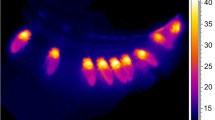Summary
The nectar foragers of a honey bee colony, upon return to the hive, sometimes perform a mysterious behavior called the tremble dance. In performing this dance, a forager shakes her body back and forth, at the same time rotating her body axis by about 50° every second or so, all the while walking slowly across the comb. During the course of a dance, which on average lasts 30 min, the bee travels about the broodnest portion of the hive. It is shown experimentally that a forager will reliably perform this dance if she visits a highly profitable nectar source but upon return to the hive experiences great difficulty finding a food-storer bee to take her nectar. This suggests that the message of the tremble dance is “I have visited a rich nectar source worthy of greater exploitation, but already we have more nectar coming into the hive than we can handle.” It is also shown experimentally that the performance of tremble dances is followed quickly by a rise in a colony's nectar processing capacity and (see Nieh, in press and Kirchner, submitted) by a drop in a colony's recruitment of additional bees to nectar sources. These findings suggest that the tremble dance has multiple meanings. For bees working inside the hive, its meaning is apparently “I should switch to the task of processing nectar,” while for bees working outside the hive (gathering nectar), its meaning is apparently “I should refrain from recruiting additional foragers to my nectar source.” Hence it appears that the tremble dance functions as a mechanism for keeping a colony's nectar processing rate matched with its nectar intake rate at times of greatly increased nectar influx. Evidently the tremble dance restores this match in part by stimulating a rise in the processing rate, and in part by inhibiting any further rise in the intake rate.
Similar content being viewed by others
References
Badertscher S, Gerber C, Leuthold RH (1983) Polyethism in food supply and processing in termite colonies of Macrotermes subhyalinus (Isoptera). Behav Ecol Sociobiol 12:115–119
Batschelet E (1981) Circular statistics in biology. Academic Press, London New York
Frisch K von (1923) Über die “Sprache” der Bienen, eine tierpsychologische Untersuchung. Zool Jb (Physiol) 40:1–186
Frisch K von (1967) The dance language and orientation of bees. Harvard University Press, Cambridge
Jeanne RL (1991) Polyethism. In: Ross KG, Matthews RW (eds) The social biology of wasps. Cornell University Press, Ithaca, pp 389–425
Lindauer M (1948) Über die Einwirkung von Duft- und Geschmacksstoffen sowie anderer Faktoren auf die Tänze der Bienen. Z Vergl Physiol 31:348–412
Michener CD (1974) The social behavior of the bees. A comparative study. Harvard University Press, Cambridge
Milum VG (1955) Honey bee communication. Am Bee J 95:97–104
Nieh JC The stop signal of the honey bee. Behav Ecol Sociobiol (in press)
Rissing SW (1984) Replete caste production and allometry of workers in the honey ant, Myrmecocystus mexicanus Wesmael (Hymenoptera: Formicidae). J Kansas Entomol Soc 57:347–350
Schneider F (1949) Über die Vergiftung der Bienen mit Dinitrokresol. Mitt Schweiz Entomol Ges 22:293–308
Schick W (1953) Über die Wirkung von Giftstoffen auf die Tänze der Bienen. Z Vergl Physiol 35:105–128
Seeley TD (1986) Social foraging by honeybees: how colonies allocate foragers among patches of flowers. Behav Ecol Sociobiol 19:343–354
Seeley TD (1989) Social foraging by honey bees: how nectar foragers assess their colony's nutritional status. Behav Ecol Sociobiol 24:181–199
Seeley TD, Tovey CA (1993) Why search time is a reliable indicator of a honey bee colony's nectar influx. Anim Behav (in press)
Seeley TD, Towne WF (1992) Tactics of dance chice in honey bees: do foragers compare dances? Behav Ecol Sociobiol 30:59–69
Seeley TD, Camazine S, Sneyd J (1991) Collective decision-making in honey bees: how colonies choose among nectar sources. Behav Ecol Sociobiol 28:277–290
Smith WJ (1977) The behavior of communicating. An ethological approach. Harvard University Press, Cambridge
Sokal RR, Rohlf FJ (1981) Biometry, 2nd edn. Freeman, San Francisco
Sorensen AA, Busch TM, Vinson SB (1985) Control of food influx by temporal subcastes in the fire ant, Solenopsis invieta. Behav Ecol Sociobiol 17:191–198
Visscher PK, Seeley TD (1982) Foraging strategy of honeybee colonies in a temperate deciduous forest. Ecology 63:1790–1801
Wilson EO (1980) Caste and division of labor in leaf-cutter ants (Hymenoptera: Formicidae: Atta). The overall pattern in A. sexdens. Behav Ecol Sociobiol 7:143–156
Author information
Authors and Affiliations
Additional information
Correspondence to: T. Seeley
Rights and permissions
About this article
Cite this article
Seeley, T.D. The tremble dance of the honey bee: message and meanings. Behav Ecol Sociobiol 31, 375–383 (1992). https://doi.org/10.1007/BF00170604
Received:
Accepted:
Issue Date:
DOI: https://doi.org/10.1007/BF00170604




